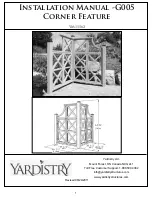
Basic Chemistry and Basic Corrosion Theory
2:26
CP 1 – Cathodic Protection Tester Course Manual
©
NACE International, 2000
02/01/05
Temperature Differences in the Electrolyte
For temperature differences in an electrolyte, the area of metal in the higher
temperature is usually the more active area and becomes the anode of the
corrosion cell.
Dissimilar Soils
Dissimilar soils, such as clay and sand, due to their differences in resistivity
(reciprocal of conductivity) and oxygen content, may provide the driving
force for corrosion. The metal in the vicinity of the lower resistivity soil is
usually more active and is the anode.
Oxygen Concentration Cell
A metal exposed to different concentrations of oxygen may experience a
difference in voltage. The metal in the vicinity of the higher concentration
of oxygen will be more noble, or the cathode, because oxygen is a cathodic
reactant.
Metal Ion Concentration Cell
The higher the concentration of metal ions that are the same as the adjacent
metal, the more the noble the metal becomes. For metal ions that are
different from the adjacent metal, the effect may be difficult to determine.
When a simple salt is present that does not contain a metal ion, the area of
the metal in the higher concentration of salt is usually the anode.
Microbiological Influences
Microbiologically induced corrosion (MIC) is common. Various bacteria
enter into redox type reactions. Some of these bacteria live only in
environments free of oxygen. This class of bacteria is termed
anaerobic
.
Other species thrive under aerated conditions and form acids. Although
bacteria themselves do not attack metals, the metals become involved in the
various redox reactions associated with the metabolism of the bacteria.
A particularly important example of MIC is sulfate reducing bacteria (SRB)
which can accelerate corrosion of metal pipe in clay environments. In the
overall cycle, the metal is oxidized and sulfur, normally present in soils as
sulfate, is reduced to sulfide. The bacteria serve as an intermediary in this
reaction. The presence of bacteria may significantly increase corrosion rates
in environments that would otherwise be relatively benign.
Содержание CP 1
Страница 1: ...CP 1 Cathodic Protection Tester Course Manual February 2005 NACE International 2000 ...
Страница 265: ......
Страница 266: ......
Страница 267: ......
Страница 268: ......
Страница 301: ...RP0169 2002 32 NACE International ISBN 1 57590 035 1 ...
Страница 535: ...TM0101 2001 24 NACE International ISBN 1 57590 137 4 ...
















































